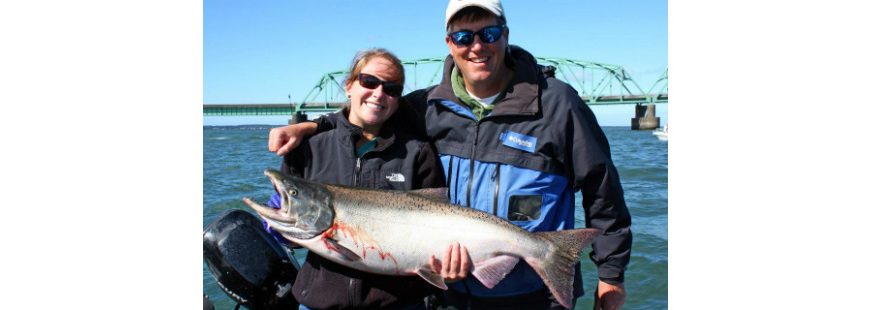Photo: Melissa Peterson with a Chinook salmon
I just got through reading an article on the anomaly of pink salmon actually returning in larger sizes than they did historically, and subsequently effecting the size and abundance of other, more highly sought-after salmon species in the region. It’s a true testament as to how complex our ocean ecosystems really are. If there’s one thing that fisherman can all agree on, it’s how challenging fisheries science is.
Bonneville Dam counts are fluctuating wildly, but managers just last week breathed a sigh of relief when adult spring Chinook started passing en masse over the facility, indicating the run was safe from a collapse many of us had blamed on the growing abundance of sea lions. I, too, prematurely called the run a bust before the big passage came on line; what do I know, I’ve only been paying attention to fish issues for two decades now….
There is a lot at risk when fisheries biologists start punching numbers through the models. Economically important sport and commercial fisheries are crafted based on these return numbers, and we have a catch-sharing agreement with the Columbia River Treaty Tribes we have to pay attention to as well. Due to past mis-predictions, the fish and wildlife departments have to hold back a buffer to ensure adequate escapement for tribal harvests. Once the run size update happens, typically in the first week of May, managers can “release” that buffer and we can go about our business of attempting to land one of these prized fishes that is so pleasing to the palate.
Just now, coming off of the effects of a pretty intense, but thankfully, not long-lived El Nino event, we have some tough times ahead, showing us that, indeed, these strong salmon returns of recent years are still susceptible to ocean anomalies. We’ll suffer another year of bad coho returns and likely another one after that. Since Chinook are longer lived, it will be another year (hopefully) before we see this stock of fish return to more modest returns.
In times like these, and as you’ve seen in the last several years from Columbia River biologists, it makes sense to manage conservatively. Since we’ve become aware that these salmon returns are volatile and hard to predict, the buffer on the Columbia River sport and especially the commercial fleet, is darn important. Managing conservatively is the tool of the future, especially as ocean conditions become more radical.
There’s not too many times where we can say as a community we’re sorry we “under-managed” a fishery. There have been a few times where we’ve left a few fish on the table that could have withstood some additional harvest, but should we really be upset that we didn’t get all that we were allotted? That management strategy always perplexed me in Alaska. The Alaska Department of Fish & Game always wanted “excess” sockeye taken from the Kenai system so there wasn’t an over-abundance of them. There may be some method to their madness, however, as when there is an over-abundance of juvenile sockeye fry, it puts a strain on available forage during their freshwater life cycle, similar to what the article states at the beginning of this post. An ecosystem, whether it be saltwater or freshwater, only has a certain carrying capacity.
In a recent meeting of the Columbia Basin Partnership, I saw a graph that explained the Pacific Decadal Oscillation and the recent interruption that we’re experiencing. Maybe that’s a good thing. This graph shows that interruption, going from what traditionally is a 10-year cycle (hence “decadal”) into a sporadic pattern that mimics the extremely good and extremely bad events we’ve had in recent years. It’s hard to complain about the good events as they have provided us some pretty spectacular salmon returns, but it’s a view into the window of how climate change will be affecting our ocean ecosystems.
Now that you have a firm grip on ecosystem management, a precautionary approach is what the Magnuson-Stevens Act is all about – proactively managing our forage fish base and implementing precautionary measures that ensure the opportunity for depressed stocks of fish to recover. Furthermore, we can’t overlook the benefits of ecosystem-based management (EBM), to look at the entire system versus single species management, which is how our fisheries have historically been managed.
As summer approaches, so does our harvest season. I’m still springer-less, but I can’t believe I’ll go all season without getting one for me and my family. We also just got off a strong upwelling event on the Pacific Coast. Let’s hope this translates into a friendly ocean for our newly arriving coho and steelhead smolts just now entering the ocean.
We now know more than we ever did about ocean ecosystems, and fishermen — both sport and commercial — are the real observers. It’s up to us to be the advocates for healthy, abundant stocks of fish that our children can fish on. Another issue everyone agrees on: we don’t want to be the generation that takes the last fish. It’s up to us to tell those who sit behind the desk for all too long that these fisheries need special attention, because we all intend to do this for as long as our bodies will allow us to.


